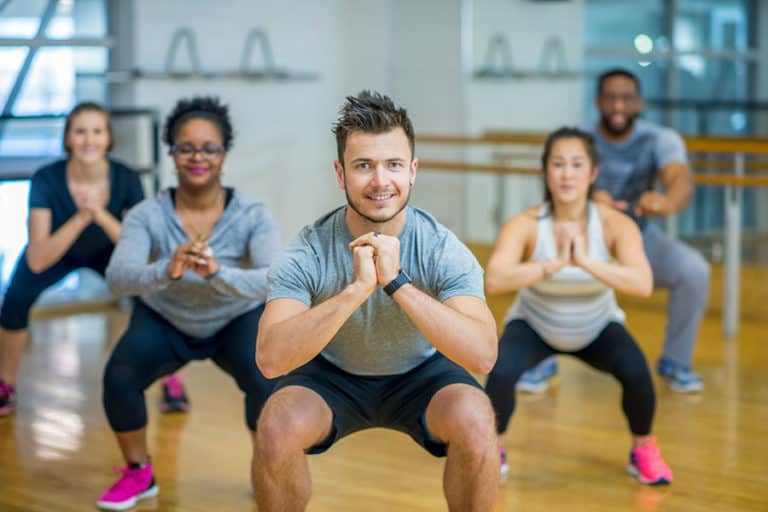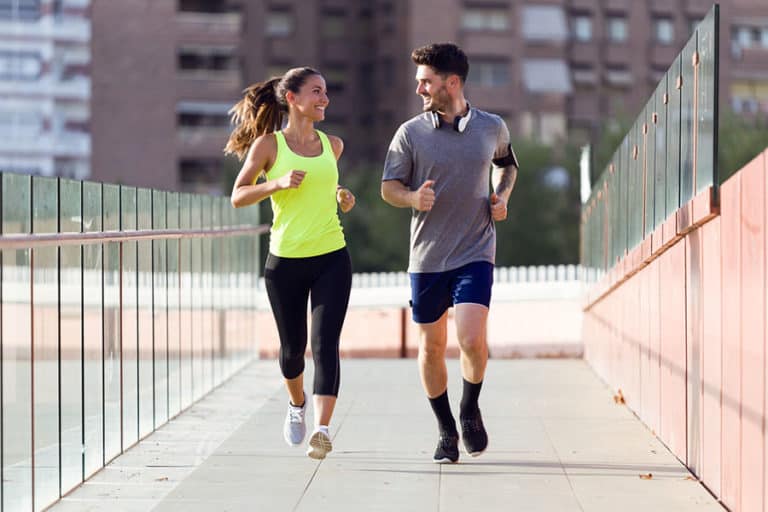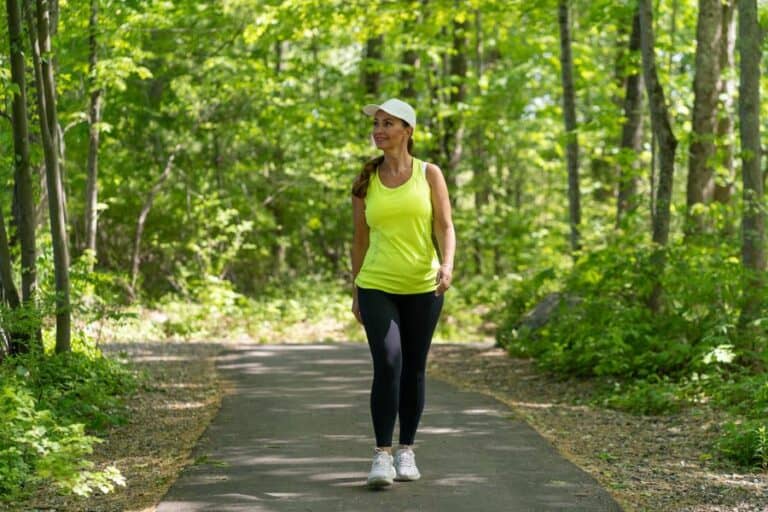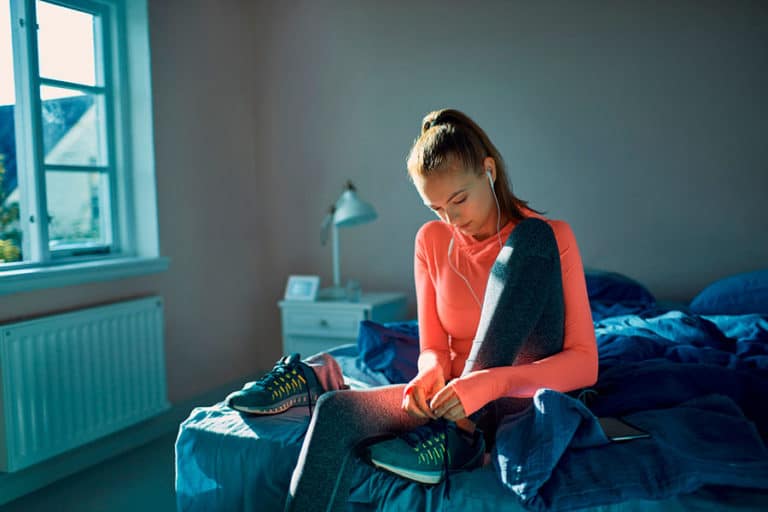Squat workout for beginners to do at home

Squat workout for beginners | Add to routine | Benefits | Safety Tips
Squats are functional exercises that can be performed anywhere by people of any fitness level. Studies [1]National Library of Medicine: The Relationship Between Maximum Unilateral Squat Strength and Balance in Young Adult Men and Women have shown that squat workouts can provide many benefits, like overall strength, balance, and health.
Squat workout for beginners (Level 1)
Listed below are different variations of squats that can be easily performed at home. These are perfect for absolute beginners who need to improve their squat form and develop the confidence to execute squats.
1. The basic squat
Target areas: Quads, hips, and glutes
How to do
- Start with your feet shoulder-width apart and your toes pointed slightly outwards.
- Slowly lower yourself down by bending your knees and hips. Keep your spine neutral throughout the movement.
- Once your thighs are parallel to the ground, pause for a few seconds.
- Slowly push through your heels and raise yourself back to the starting position.
Summary: A basic squat can be done without any weights and is, therefore, easy to perform regularly at home. The combined range of motion and the pressure that it builds on your muscles makes this a good workout for your entire lower body.
2. The wall squat
Target areas: Glutes, abs, quads, hamstrings, and calves
How to do
- Stand with your back against a wall and your feet shoulder-width apart.
- Take two steps forward with your back still leaning against the wall.
- Slowly lower yourself down the wall by bending your knees and lowering your hips.
- Stop when your thighs are parallel to the ground, then slowly raise yourself back to the starting position.
Summary: The wall squats are perfect for a home workout since they don’t require any equipment. The wall provides stability and support, making this a good option for beginners. It is also a great way to tone your lower body without putting too much strain on your joints.
3. The box squat (bodyweight)
Target areas: Quads, glutes, calves, and core.
How to do
- Start by standing with a box or bench behind you.
- Place your feet shoulder-width apart.
- Lower yourself down by bending your knees.
- Stop when your glutes touch the box, and then rise back up.
Summary: There are many variations of box squats that you can try. The version given above is a bodyweight box squat. It is a beginner-friendly variation of weighted box squats. This variant requires neither a barbell nor a squat rack. A box or bench of optimum height is all the equipment you need.
4. The pulse squat
Target areas: Quads, hamstrings, hip flexors, glutes, calves, adductors, and core
How to do
- Start in the same position as the basic squat.
- Keep your spine erect and extend your arms straight in front of you.
- Bend your knees and lower your hips for the downward movement.
- Stop when your thighs are parallel to the ground, and then pulse up and down for 30 seconds.
Summary: The pulse squat variation is excellent for toning your lower body muscles and improving your cardiovascular endurance. The addition of the pulse at the bottom of the squat also works your muscles harder, making this a great option for those looking for a more challenging workout.
5. The jump Squat
Target areas: Quads, glutes, calves, core
How to do
- Start with your feet hip-width apart and your hands at your sides.
- Keeping your back straight, slowly lower your hips down.
- Stop when your thighs are parallel to the ground.
- From this position, jump with an explosive movement.
- Land softly on your feet and lower yourself back into the squat position.
Summary: The jump squat is a plyometric exercise that can add explosive power to your lower body. The impact of the jump also works your muscles harder.
Squat workout for beginners (Level 2)
Once you have developed the confidence required to execute the above squats, you can progress to the next set of squats we have put together. The range of motion in these squats is slightly more challenging but not too difficult to execute.
6. The sumo squat/Plié squat
Target areas: Quads, hamstrings, hip flexors, glutes, calves, adductors, and core.
How to do
- Stand with your feet wider than shoulder-width apart.
- Keep the arms bent, elbows pointing downwards, wrists held in a clasp in front, and your toes turned out.
- Lower your hip by bending your knees. Keep your back straight throughout.
- Squat until your thighs are past the parallel, then slowly raise yourself back to the starting position.
Summary: The wide stance of the sumo squats makes it a great exercise for targeting the inner thigh muscles (adductors). It also works all the other major muscle groups in the lower body.
7. The air squat
Target areas: Quads, glutes, hamstrings, and core.
How to do
- Start with your feet shoulder-width apart and toes pointed outward.
- Keep your arms loose and in a neutral position by your sides.
- Engage your core and start lowering your hips. Descend until your hips are below your knees.
- As you start the descent, raise your arms until they are at chest level.
- Return to the starting position by pressing through your heels, driving your hips upwards, and bringing your arms back to your sides.
Summary: Air squats are a great way to work your lower body and core at the same time. They are also relatively easy to do and can be performed by people of all fitness levels, from beginner to advanced.
8. The bulgarian split squat
Target areas: Quads, glutes, hamstrings, calf muscles, and core
How to do
- Start by placing a bench behind you and stand at a distance of roughly 1- 2 feet from the bench.
- Stand with your back facing the bench.
- Place your left foot on the bench behind you.
- Keep your right leg firmly planted on the ground.
- Keeping your chest up and your core engaged, lower yourself down by bending the knee of the right leg.
- Stop when your right thigh is parallel to the ground.
- Now, press through your right heel to return to the starting position.
Summary: The Bulgarian squat is an excellent way to target all the major muscles in the lower body. It can be performed by people of all fitness levels, from beginner to advanced. It is easy to adapt this squat exercise into a home workout routine.
Squat workout for beginners (Level 3)
The squat exercises listed under this level require a good level of control, balance, and flexibility. Try these once you have perfected your squat form, depth, and range of motion with the squats mentioned in the first and second levels.
9. The pistol squat
Target areas: Glutes, calves, quads, hip flexors, and core.
How to do
- Start by standing on one leg with the other leg raised in front of you.
- Lower your hip by bending your knees. Keep your back straight throughout.
- Squat as deep as possible. Ideally, descend until your glutes touch your shins or heels.
- Slowly raise yourself back up to the starting position.
Summary: Pistol squats are a unilateral [2]Research Gate: Unilateral and bilateral exercise movements: Considerations for Program Design squat form. This means that they work one leg at a time. As such, it corrects muscle imbalances and develops stability in the lower body. This squat variation is challenging and should be attempted only by people who have a good level of fitness.
10. Cossack squat
Target areas: Inner and outer thighs, glutes, hamstrings, and core.
How to do
- Start by standing with a wide stance.
- Move your weight onto the right leg and squat steadily while keeping your torso upright.
- Ensure your right knee is inline with your toes.
- Extend your left leg fully.
- Keep your left heel firmly planted on the floor with the toes facing upwards.
- Keep your arms extended or clasped in front for balance.
- Pause for a moment, and drive up from your right leg to return to the standing position.
- Repeat the move on the other side.
Summary: A cossack squat is a great way to work your inner and outer thighs. The movement pattern of this squat stretches and works the muscles in a different way than traditional squats. It is a good exercise for people who are looking to improve their flexibility.
11. Lateral squat
Target areas: Glutes, quads, and inner thighs
How to do
- Start with your feet positioned wider than your shoulders- in a wide “v”.
- Bend your right knee and lower your hips into a squat.
- Meanwhile, your opposite leg is extended straight with the foot flat on the floor.
- You may let your hands hang loose or interlace your fingers in front of you for counterbalance.
- Press through your right heel and return to the starting position.
- Repeat the movement on the left side.
Summary: The lateral squat improves resistance to rotational forces and enhances strength, mobility, and control in the lower body. By promoting balance and coordination in the muscles, this exercise can help prevent injuries. It is a great exercise for people of all fitness levels and can be performed anywhere.
A sample squat workout routine for beginners
We have combined the above-mentioned squats into a sample workout routine, segregated on the basis of fitness levels.
| Fitness level | Squat Type |
| Beginner level 1 | Basic Squat – 2 – 3 sets of 12-15 reps Wall Squat – 2 – 3 sets of 5 reps with 20 seconds holding the pose Box Squat – 3 – 4 sets of 10-12 reps Pulse Squat – 3 – 5 sets of 8 – 15 reps (3 pulses each) Jump Squat – 3 – 4 sets of 10 – 15 reps |
| Beginner level 2 | Air Squat – 2 – 3 sets of 10 – 15 reps Sumo Squat – 2 – 3 sets of 6- 8 reps Bulgarian squat – 2-3 sets of 10-15 reps |
| Beginner level 3 | Pistol Squat – 2 – 3 sets of 10 – 15 reps on each side Cossack Squat – 5 – 7 sets of 8 – 10 reps on each side Lateral Squat – 5-7 sets of 8-10 reps on each side |
The benefits of doing squat workout daily
Squats can offer several benefits for your lower body, upper body, and core. They strengthen your legs, improve your range of motion and develop functional strength. Listed below are the benefits of squats based on the regions of the body that they impact.
Lower-body
Squats are a great exercise for toning and strengthening the lower body. In addition to increased flexibility and strength in the hips, thighs, and calves, squats can help improve muscle definition and prevent injury.
Upper body
When performed with weights, squats can also help tone your arms and shoulders. In certain formats, squats help to improve the health of your spine and improve your posture.
Core
Squat movement necessarily engages the core muscles resulting in better muscle tone and strength in the abdominal region. As a result, they also help to improve balance and stability.
Joints
Research [3]PubMed: Analysis of the load on the knee joint and vertebral column with changes in squatting depth and weight load has shown that squatting can help to improve joint health. The increased flexibility and range of motion in your hips, knees, and ankles can help to prevent joint pain and stiffness. It also improves the health of your cartilage and connective tissues.
Tips to avoid injury when doing squat exercises
It is very easy to injure oneself when doing any type of exercise. Squats, in particular, can be hard on the knees if not done correctly. Here are a few tips to help avoid injury when doing squat exercises:
- Warm up before you start performing squats.
- Start with bodyweight squats and progress to weighted squats.
- Make sure you have good form. Don’t arch your back or let your knees go past your toes.
- Wear supportive shoes and work out in a safe environment.
- Stop if you feel any pain.
- Focus on using your glutes and quads, not your lower back.
- Don’t lock your knees at the top of the squat.
- Cool down and stretch after your workout.
Conclusion
When done correctly, squat exercises can be a great way to tone and build muscle in your lower body. If you follow the above tips, you can minimize your risk of injury and maximize your results.
References






